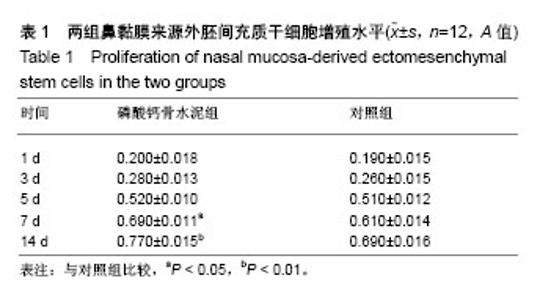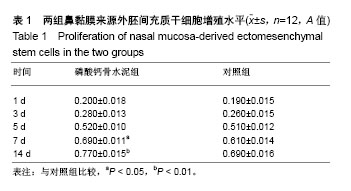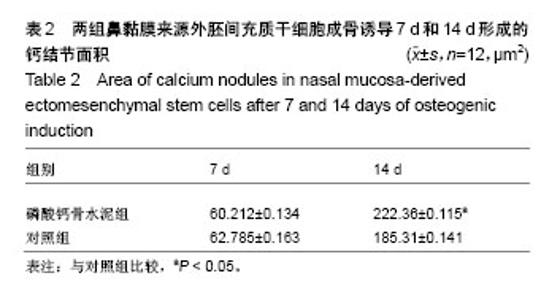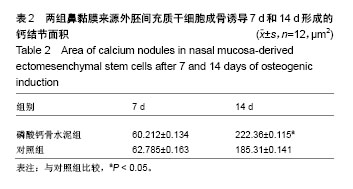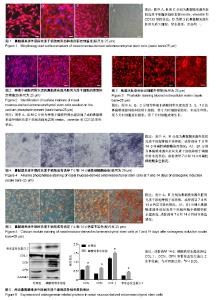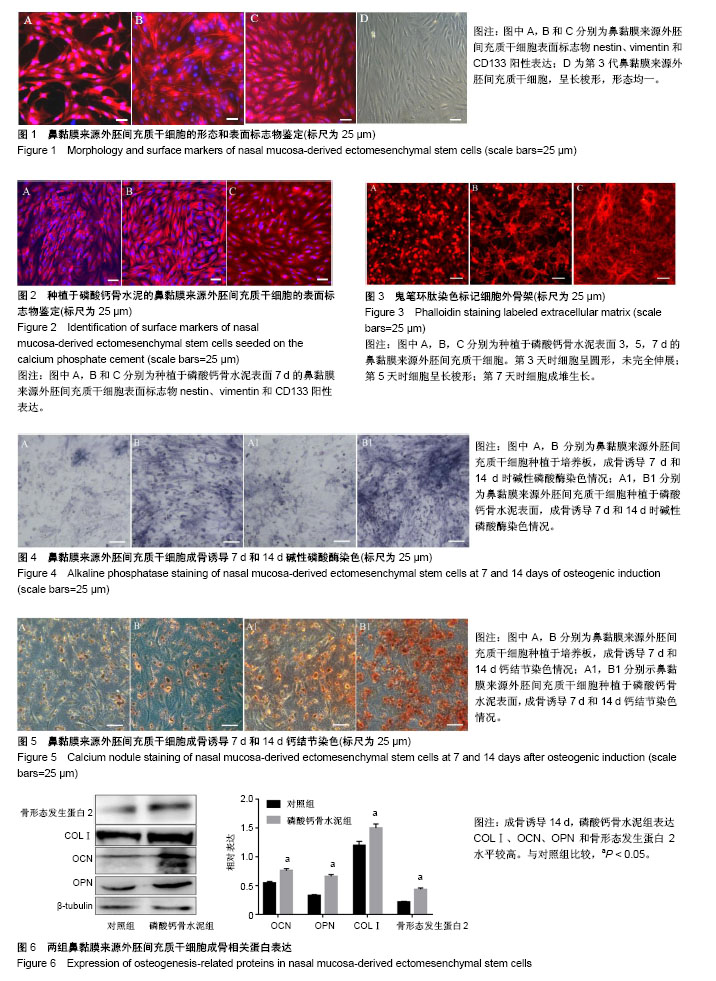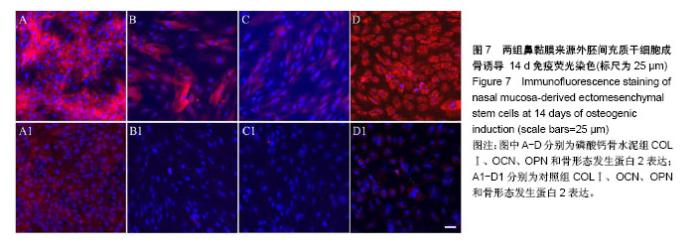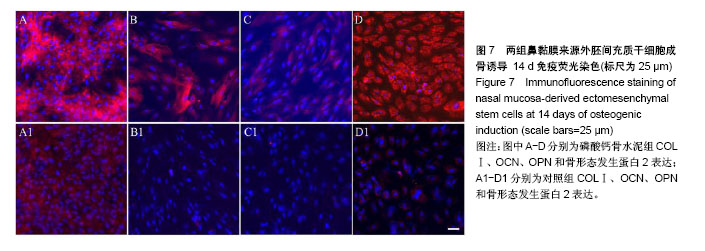| [1] 王海波,杨新明,张瑛,等.大段骨缺损修复的组织工程学研究进展[J].中华生物医学工程杂志,2013,19(1):73-76.[2] Kiernan CH, Wolvius EB, Brama PAJ, et al. The Immune Response to Allogeneic Differentiated Mesenchymal Stem Cells in the Context of Bone Tissue Engineering.Tissue Eng Part B Rev. 2018;24(1):75-83. [3] 王小志,何惠宇,杨楠,等.基因转染骨髓间充质干细胞复合同种异体骨修复绵羊极限骨缺损[J].中国组织工程研究, 2013,17(47):8141-8148.[4] Smith BT, Santoro M, Grosfeld EC, et al. Incorporation of fast dissolving glucose porogens into an injectable calcium phosphate cement for bone tissue engineering. Acta Biomater. 2017;50:68-77. [5] Chen Q, Zhou H, Hu P.Stemness distinctions between the ectomesenchymal stem cells from neonatal and adult mice. Acta Histochem. 2017;119(8):822-830. [6] 张志坚,刘锦波,姜平,等.大鼠嗅粘膜原代培养细胞的分类及细胞社会学特性研究[J].江苏大学学报(医学版),2004,14(1):4-7,96.[7] Zhang Z, He Q, Deng W, et al. Nasal ectomesenchymal stem cells: multi-lineage differentiation and transformation effects on fibrin gels.Biomaterials. 2015;49:57-67. [8] Delorme B, Nivet E, Gaillard J, et al. The human nose harbors a niche of olfactory ectomesenchymal stem cells displaying neurogenic and osteogenic properties.Stem Cells Dev. 2010;19(6):853-866. [9] Chen Q, Zhang Z, Liu J, et al. A fibrin matrix promotes the differentiation of EMSCs isolated from nasal respiratory mucosa to myelinating phenotypical Schwann-like cells.Mol Cells. 2015;38(3): 221-228. [10] 黄秋生,陆汉强,周月鹏,等.成人鼻黏膜间充质干细胞的体外培养和多向诱导分化[J].临床耳鼻咽喉头颈外科杂志, 2012,26(11):490-493,498.[11] Shu X, Feng J, Feng J, et al. Combined delivery of bone morphogenetic protein-2 and insulin-like growth factor-1 from nano-poly (γ-glutamic acid)/β-tricalcium phosphate-based calcium phosphate cement and its effect on bone regeneration in vitro.J Biomater Appl. 2017;32(5):547-560. [12] Darby I.Periodontal materials.Aust Dent J. 2011;56Suppl 1:107-118. [13] 温世锋,刘清华,郭奇峰,等.新型磷酸钙骨水泥与骨髓间充质干细胞的共培养研究[J].临床医学工程,2009,16(11):1-4.[14] Gallinetti S, Mestres G, Canal C, et al. A novel strategy to enhance interfacial adhesion in fiber-reinforced calcium phosphate cement.J MechBehav Biomed Mater. 2017;75:495-503. [15] Qiu G, Shi Z, Xu HHK, et al. Bone regeneration in minipigs via calcium phosphate cement scaffold delivering autologous bone marrow mesenchymal stem cells and platelet-rich plasma.J Tissue Eng Regen Med. 2018;12(2):e937-e948. [16] Martin FT, Dwyer RM, Kelly J, et al. Potential role of mesenchymal stem cells (MSCs) in the breast tumour microenvironment: stimulation of epithelial to mesenchymal transition (EMT).Breast Cancer Res Treat. 2010;124(2):317-326. [17] Tohyama T, Lee VM, Rorke LB, et al. Nestin expression in embryonic human neuroepithelium and in human neuroepithelial tumor cells.Lab Invest. 1992;66(3):303-313. [18] Richardson GD, Robson CN, Lang SH, et al. CD133, a novel marker for human prostatic epithelial stem cells.J Cell Sci. 2004;117(Pt 16): 3539-3545. [19] 边兴艳.MTT比色法及其应用[J].国际检验医学杂志, 1998,19(2):83-85.[20] Bessey OA, Lowry OH, Brock MJ.A method for the rapid determination of alkaline phosphates with five cubic millimeters of serum.J Biol Chem. 1946;164:321-329. [21] Kulikowski E, Halliday C, Johansson J, et al. Apabetalone Mediated Epigenetic Modulation is Associated with Favorable Kidney Function and Alkaline Phosphatase Profile in Patients with Chronic Kidney Disease.Kidney Blood Press Res. 2018;43(2):449-457. [22] Tang J, Saito T.Elucidation on Predominant Pathways Involved in the Differentiation and Mineralization of Odontoblast-Like Cells by Selective Blockade of Mitogen-Activated Protein Kinases.Biomed Res Int. 2018;2018:2370438. [23] Miller EJ. Collagen types: Structure, distribution, and functions. Collagen: CRC Press, 2018:139-156. [24] McCully M, Conde J, Baptista P, et al. Nanoparticle-antagomiR based targeting of miR-31 to induce osterix and osteocalcin expression in mesenchymal stem cells.PLoS One. 2018;13(2):e0192562. [25] Rickard DJ, Sullivan TA, Shenker BJ, et al. Induction of rapid osteoblast differentiation in rat bone marrow stromal cell cultures by dexamethasone and BMP-2.Dev Biol. 1994;161(1):218-228. [26] Cha JK, Jung UW, Thoma DS, et al. Osteogenic efficacy of BMP-2 mixed with hydrogel and bone substitute in peri-implant dehiscence defects in dogs: 16 weeks of healing.Clin Oral Implants Res. 2018; 29(3):300-308. [27] Muñoz-Pacheco JM, Zambrano-Serrano E, Félix-Beltrán O, et al. Synchronization of PWL function-based 2D and 3D multi-scroll chaotic systems. Nonlinear Dynamics. 2012;70(2):1633-1643. |
